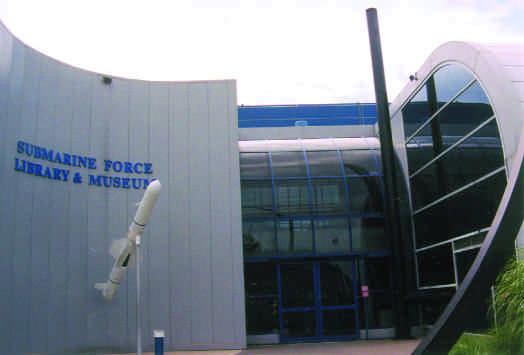
27 minute read
Visiting the Submarine Force Library and Museum
The Submarine Force Library and Museum had its origins in a collection of books, records, and artifacts begun by the Electric Boat Company in the 1950s. After it was donated to the Navy in 1964, the collection was moved to the Naval Submarine Base New London, where it remained until 1986.
In April of that year, the Library and Museum finally opened in its own dedicated facility on the Thames River, located just outside the submarine base. Today, the museum complex consists of three main elements: the Museum itself, the Library and Archives, and the historic ship USS Nautilus (SSN-571).
Advertisement
Visiting the SUBMARINE FORCE L I B R A R Y A N D M U S E U M

The Museum
Arriving at the submarine museum, visitors first encounter a number of displays outside the main building itself. These set the stage for many of the exhibits inside and give the museum a venue for displaying many items that simply will not fit elsewhere.
The most prominent of these outdoor displays is the complete sail from USS George Washington (SSBN-598), which stands in front of a monument dedicated to the Polaris program and the first “41 for Freedom” ballisticmissile submarines. Together with the nearby top section of a Polaris launch tube, complete with open hatch and missile cover, it forms an i m p re s s i ve remembrance of our earliest seaborne nuclear deterrent.
The unique entryway of the Submarine Force Museum consists of a large 40-foot outer ring – representing the hull diameter of an Ohio-class SSBN – and a ninefoot inner counterpart that contrasts the hull diameter of the U.S. Navy’s first submarine, USS Holland (SS-1), commissioned in 1900.
Four unusual mini-submarines and submersibles are arrayed next to the entrance: • HA-8, a Japanese Type-A mini-submarine. Five craft of this design participated in the Japanese attack on Pearl Harbor. • X-1, the US Navy’s first midget submarine design, built in 1955 to test U.S. defenses against enemy counterpart s . Originally powered by an experimental h yd ro g e n - p e roxide propulsion system, X-1 was converted to conventional propulsion after a 1957 explosion destroye d much of her original bow. • A Mk VII Swimmer De l i ve ry Ve h i c l e ( S DV) , an early U.S. Navy design now replaced by larger and more sophisticated versions. • An Italian “chariot,” or swimmer delivery vehicle, similar to the maiale (“pig”) types used to attack British ships during World War II.
Rounding out the collection is a World War II submarine deck gun from USS
One wing of the museum deals primarily with modern submarines. Exhibits focus on the strategic deterrence pro g r a m , including Polaris, the former submarine base at Holy Loch, Scotland, and similar aspects. There is also a cutaway model of a USS Los An g e l e s (SSN-688)-class
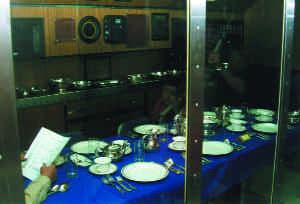
submarine and a display on submarine contributions to Operation Desert Storm and other recent conflicts.
The other wing houses several largescale historical displays, beginning with a replica of the first combat submersible, Tu rt l e, from the Re vo l u t i o n a ry Wa r. Associated exhibits describe the evolution of submarines over the centuries. The contrast between the crude hand-cranked Turtle and modern submarines is striking, yet both had the same goal – to seek out and destroy the nation’s enemies.
In addition to Turtle, a McCann Rescue Bell dominates this section of the museum, and there is also a small exhibit on the 1939 rescue of crewmembers from the stricken USS Squalus (SS-192), which made the McCann bell famous.
Much of the remaining space is dedicated to Submarine Fo rce achievements in World War II. A cutaway model of a USS Gato (SS-212)-class submarine hangs
Pi ra n h a (SS-389) and several other art i f a c t s .
To enter the museum building, visitors pass through an interesting archway. A ring 40 feet in diameter represents the hull diameter of an Oh i o-class SSBN. Suspended inside is a 9-foot ring marking the diameter of USS Holland (SS-1), the Navy’s first submarine. This provides a striking reminder of the dramatic advances achieved in submarine technology since 1900, when Holland was commissioned.
Once inside, the first thing a visitor sees is an earlier Nautilus – not a real submarine, but the version imagined by Jules Verne in his novel Twenty T h o u s a n d Leagues Under the Sea. A model of the submarine created for the 1954 Walt Disney movie of Verne’s classic hangs in the entryw a y. Ne a r by there are two hands-on exhibits ideal for younger visitors – a replica of a World War II submarine attack center, complete with functioning periscopes, and a submarine control room.
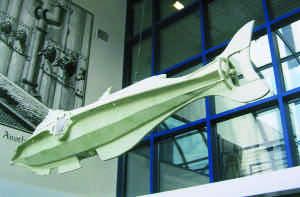
over the area, helping visitors to appreciate how little space was available onboard these vessels. (It is interesting to compare this wartime submarine with Na u t i l u s, only a decade later. While the basic configuration is much the same, nuclear power was clearly a great improvement for crew
(above) The wardroom onboard USS Nautilus (SSN-571) is displayed behind a plexiglass partition for visitors to the historic ship.
(left) Suspended just inside the museum’s entrance is a large-scale model of Captain Nemo’s fictional Nautilus, created for the 1954 Walt Disney film of Jules Verne’s Twenty-Thousand Leagues Under the Sea.
habitability, as well as submarine performance.) Other exhibits describe both combat operations and life onboard wartime submarines. Rotating displays of historical artifacts from the museum’s archives honor individual boats. These displays are often a r r a n g e d to coincide with crew reunions or other events at the museum.
Finally, one wall is dedicated to submarine armament. There are a number of torpedoes and other submarine we a p o n s , ranging from a 1918 Whitehead design to the modern Mk 48 and a SUBROC ro c k e t - propelled nuclear depth charge. As an adjunct to the many other displays on SSBNs and strategic deterrence, there is a demilitarized Polaris missile on hand, sectioned to show the complexity of its internal workings.
As visitors head out of the museum building t ow a rd Na u t i l u s, they pass a wall of models, re p resenting eve ry class of U.S. submarines f rom Ho l l a n dto USS Seawolf (SSN- 21).
The centerpiece of the Submarine Force Museum is the decommissioned USS Nautilus (SSN-571), the world’s first nuclear submarine. Commissioned in late 1954, she served until 1980 and after deactivation of her reactor, was opened to the public in April 1986. Nautilus remains afloat in the Thames River but moored to the museum pier with a set of articulating brackets. She was briefly overhauled in 2002 and still serves the Submarine School as a training aid.

Historic Ship Nautilus
Adjacent to the main building, the centerpiece of the museum’s collection – USS Na u t i l u s (SSN-571) – is moored in the Thames Rive r. The world’s first nuclearp owe red submarine – indeed, the world’s first nuclear-powe red ship of any sort –Na u t i l u s m a rked a major re volution in submarine technology, and with her, submarines became truly independent of the ocean’s surface. Commissioned in September 1954, Na u t i l u s rapidly prove d the value of nuclear propulsion, setting a number of speed and endurance re c o rd s and re volutionizing submarine tactics. The famous signal, “Nautilus 90-No rt h , ” cemented the submarine’s place in the popular imagination, when she became the first ship to sail directly over the No rth Po l e . Na u t i l u s s e rved a distinguished 25-ye a r c a reer as a warship, while also testing equipment and technology for her successors.
Fi ve years after Na u t i l u s d e c o m m i ssioned in 1980, she was towed to Groton and became part of the Submarine Force Museum when it opened to the public in April 1986. (In 2002, Nautilus was briefly removed from the museum for an overhaul at Electric Boat, where she was originally built, but has since returned). The boat is firmly moored to the pier by a set of articulating brackets, but she remains afloat and is maintained in excellent condition.
The only U.S. nuclear-powered submarine currently on public display, Nautilus g i ves visitors a re m a rkable glimpse of history and naval technology. The ship is preserved in nearly the same condition she was in during her active life, quite impressive for a ship nearly 50 years old. Selected portions of the forward section of the submarine – the torpedo room, wardroom, control room, attack center, crew’s mess, and several other areas – are open to the public, with a self-guided audio tour available. The audio tour describes each space as guests walk and climb through the submarine. The route is delimited by clear partitions that protect the ship from the wear and tear of passing hands (and vice versa, perhaps).
The (aft) engineering half of the submarine is preserved in similar condition; the machinery is still in place, though the reactor has, of course, been defueled. Since submarine nuclear propulsion technology, even Nautilus’, could aid a country that does not have high speed, long distance submersibles (which only nuclear propulsion can provide), this section is not accessible to civilians, but Submarine School students visit regularly to gain a better understanding of the history of the systems they operate. Although technical details have changed, modern nuclear submarines operate on the same basic principles established onboard Na u t i l u s nearly 50 years ago.
The Library
As important as the museum itself, the Submarine Fo rce Library plays a major role in educating both the public at large and members of the submarine community about the history and traditions of the force.
Electric Boat began the library as a resource for its designers and engineers with the ambitious goal of gathering every a vailable publication related to submarines. The collection eventually outgrew its original home at Electric Boat, but rather than disposing of it, EB donated it to the Navy, which relocated it to the
submarine base. The Navy has continued to maintain and expand the library’s holdings until it is now the single largest collection of material related to U.S. Navy submarines outside of Washington, DC.
The library currently maintains historical files for each individual submarine in the U.S. Navy, past and present. It also has an extensive collection of books, periodicals, news clippings, and photographs
The mission of the Submarine Force Library and Museum is to preserve the rich heritage of the U.S. submarine community for future generations.
about the Submarine Force in general. The library holds an extensive oral history collection, including accounts collected by both the U.S. Naval Institute and the library itself.
The library’s unique collection makes it an invaluable re s o u rce for historical re s e a rch. Users range from private individuals, often re s e a rching the history of family members who served on submarines, to academics preparing books or papers, to students at the Submarine School. Each basic enlisted class re s e a rches a specific submarine using the library’s re s o u rces, thus emphasizing the living connection betwe e n past, present, and future submariners.
Plans for the Future
Since it opened in 1986, the museum has seen significant changes, including the addition of a new wing in 2000. And, of course, additional enhancements are always in the works.
The museum’s director (and Nautilus Officer-in-Charge), LCDR Frank Sides, hopes to add one of the Deep Submergence Rescue Vessels, possibly My s t i c (DSRV-1), to the outdoor display, when the DSRV is replaced by a planned nextgeneration submarine rescue system.
Archivist Wendy Gully said the library plans to expand its oral history efforts to ensure that the memories and experiences of submarine veterans are passed on to f u t u re generations of submariners and historians. The library also hopes to increase the exploitation of its resources by Submarine School classes, and one concept under discussion is for each officer
The Submarine Memorial
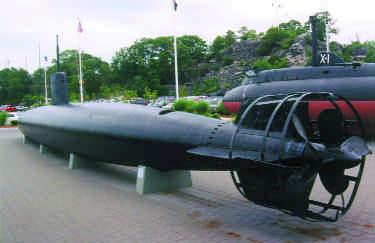
Located just two miles south of t he Subma r i ne Force Museum is ano t her no t e w o r t hy site, the National Submarine Memorial – East, maintained by the United States Submarine Veterans of World War Two. (A west-coast counterpart is located in Seal Beach, California.)
Although not officially connected to the Submarine Force Museum, the memorial complements the museum’s mission of reminding the public about the historic role of the Submarine Force. The monument is dedicated to submarines and submariners still “on final patrol” from World War II. Its focal point is the conning tower from USS Flasher (SS-249), which held the record for most tonnage sunk by a submarine during the war.
Decorative stones surrounding the conning tower list the 52 U.S. submarines lost during that conflict, giving the date and circumstances, where these are known. A black granite memorial wall lists the names of the 3,617 submariners killed in the war, a stark reminder of their sacrifice.
class passing through the school to research one of the eight Submarine Force Medal of Honor winners.
But whatever the future brings, the Submarine Force Library and Museum will continue its mission of preserving the rich heritage of the U.S. submarine community for future generations. Mr. Schoene is a naval analyst and writer living in Arlington, Virginia. He has previously written for the U.S. Naval Institute Proceedings and Naval Forces magazine.
(clockwise from top) Displayed outdoors is this Japanese Type-A mini-submarine of the type that took part in the attack on Pearl Harbor, 7 December 1941. Also part of the outdoor exhibit is this Mk VII Swimmer Delivery Vehicle, used by U.S. Navy SEALS until replaced by larger and more sophisticated versions. X-1, the first U.S. Navy mini-submarine, was built in 1955 both to investigate defenses against foreign counterparts and to demonstrate an experimental hydrogen-peroxide propulsion system – which exploded two years later.
Near the end of an unusually long refit necessitated by major repairs to her fairwater planes, USS Kentucky (SSBN-737) has her starboard plane reinstalled at IMF Bangor. Accomplished while the ship was afloat, this delicate evolution required skillful coordination among crane operators, riggers, and the entire waterfront crew.
After spending more than nine weeks in an unusually complex refit, USS Kentucky (SSBN-737) slipped confidently into the open waters of Hood Canal on 19 April in preparation for her next patrol. With 100,000 production man-hours executed in the completion of more than 1,000 individual jobs, her refit was a firstever demonstration of a new surge maintenance capability in the Pacific Northwest.
The Naval Intermediate Maintenance Facility (IMF) at Naval Submarine Base, Bangor, knew early-on that the normal refit period of four weeks would be insufficient to perform all the repairs and refurbishments needed by Kentucky. The ship had previously reported noise in the fairwater planes while underway and had asked the IMF to consider what repair options might be available when she returned from patrol.
Because the ship was already operating outside of her fairwater plane specifications on a temporary waiver, and since one of the planes appeared to be out of alignment, it was determined that both planes would have to be removed for inspection and re p a i r. Although TRIDENT Re f i t Facility (TRF) Kings Bay had already performed temporary repairs on the stock and hubs for Kentucky ’s fairwater planes while
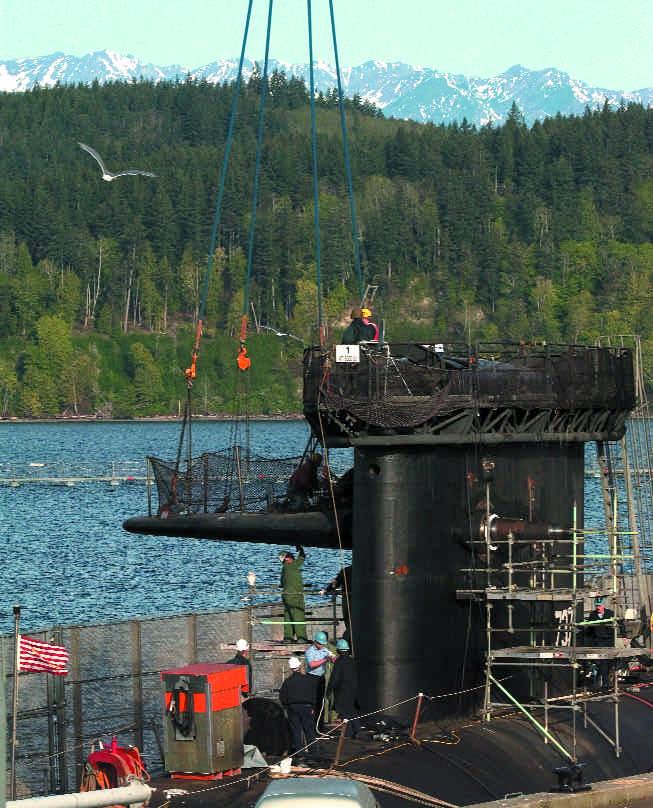
entuck R E T U R N S TO PAT R O L K A Quiet
she was homeported on the East Coast, both the Fleet and the IMF decided that it was time to examine alternatives for a permanent fix.
When the ship docked on 12 February, IMF immediately disassembled both fairwater planes and discovered that saltwater intrusion and significant corrosion had caused serious deterioration in their material and operational condition.
Fairwater planes are horizontally disposed control surfaces – “wings” – mounted on the sail for controlling the ship’s angle of rise or dive while submerged and underway. Given the importance of keeping them in peak condition and operating quietly, IMF considered several options. The principal concerns were safety and cost control. Although IMF has been accomplishing depot-level repairs and refurbishment on major components of the TRIDENT submarines for years –replacing main propulsion shafts and overhauling SSTGs and SSMGs, for example –they had never completely disassembled submarine fairwater planes. This type of work would normally be undertaken by the Naval Shipyards, but given the constant use of their drydocks and the consequent necessity of a long shipyard availability, the operating schedule of the submarine would have been compromised. Mo re ove r, the rapid deterioration of Kentucky’s fairwater planes demanded an early solution.
According to CDR John Baldwin, IMF Production Management Assistant (PMA), and head of the project, a team of engineers, planners, machinists, and other shop leaders from the IMF, Puget Sound Naval Shipyard and Intermediate Maintenance Facility (PSNS&IMF), Naval Sea Systems Command (NAVSEA), and Electric Boat pulled together to consider repair options. “This was a major team effort by nearly everyone involved in ship maintenance to apply the On e Shipyard concept to resolve a maintenance issue for the Navy,” said Baldwin. “Once we got in there and saw the extent of the damage, it became clear that we were going to have to rethink completely the way the repair was going to take place in order to get the ship back to sea quickly. The IMF had a window of opportunity in its maintenance schedule for other in-port submarines and potentially could perform permanent repairs during the Kentucky’s upcoming scheduled refit,” he added.
The team determined that there were essentially three options. The first – which would leave the ship’s schedule unchanged – was to perform another temporary repair, reassemble the planes with their existing deficiencies, and defer the permanent repair until the ship went into a major shipyard overhaul. Howe ve r, because there was no guarantee that this approach would correct the problem, and the life expectancy of the temporary fix was unknown, it was considered the highest-risk alternative, even though it could have been accomplished during a normal refit and at low cost.
The second option was to send the planes and stock back to Newport News Shipbuilding, which had conducted similar repairs in the past for other submarines homeported at Kings Bay. Given the size and weight of the components, this would have been extremely expensive and time consuming. The fairplane stock – essentially the horizontal axle for rotating the planes – weighs 13,600 pounds, and each plane alone weighs about 25,800 pounds.
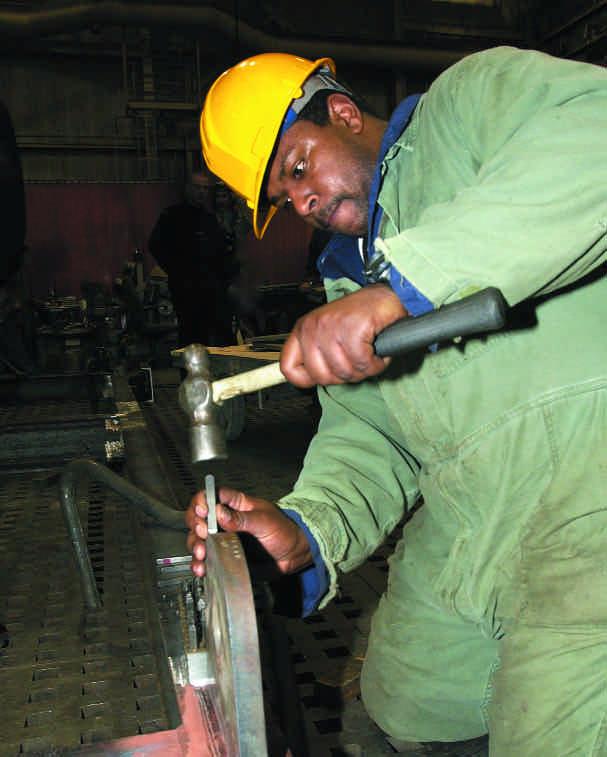
The latter, when standing vertically, are 17 feet high by 15 feet wide, which precluded shipping them by air. Even if speciallyconfigured trucks could deliver them to the East Coast, New p o rt News was extremely busy at the time and unable to complete the job in the narrow window available.
The third option – the one ultimately selected – was to do the job in-house at the I M F, with significant participation by a large Navy-contractor team. This appro a c h ended up breaking new ground, not only among the maintenance providers in the Pacific No rt h west, but Na v y - w i d e . Se c re t a ry of the Navy Go rdon England has said that the common thread of his initiat i ves over the last three years has been to i m p rove the management and efficiency of our naval forces. Within the maintenance c o m m u n i t y, a Transformation Plan has been in pro g ress to subsume all maintenance activities into a “One Sh i p y a rd” concept in order to gain greater efficiencies and e f f e c t i veness in serving the fleet. Ke n t u c k y was an early beneficiary, and ultimately her design integrity was re s t o red, and her operational schedule maintained.
The plan incorporated the ideas and best practices from a number of contributors, including the IMF, PSNS&IMF, NAVSEA, and private contractors. The highly complex job was made even more difficult by the need for significant welding on the fairplane stock, an HY (High Yield) 100 alloy forging for which the Navy had no approved welding procedures. Additionally, there were complex metallurgic issues and the requirement for a very large lathe for final machining.
“The IMF proposed a plan for the
A mechanic stamps the weight limit and test date on the Navy’s first vertical fairwater plane stand, fabricated inhouse at IMF Bangor.
repairs we intended to conduct and the technical methods and pro c e d u res we would carry out. Then, as the Navy’s technical authority, NAVSEA 07T had to evaluate them and provide concurrence,” said CDR Baldwin. “In addition, we needed to work with Commander, Submarine Sq u a d ron 17 (CSS-17), Commander, Submarine Group 9 (COMSUBGRU-9), and Commander Submarines Pacific Fleet (COMSUBPAC) to assure them that not only could we complete the repairs in a timely manner, but also that the end result would pass all tests and meet operational
specifications,” he concluded. This became the first-ever repair outside a shipyard on components that are not normally even addressed during a major two-year overhaul. Moreover, IMF had no authoritative source documents or procedures to accomplish the work.
“The lead engineer for ship control systems, Mark Mosely, developed a detailed checklist of required measurements and troubleshooting steps for our shops when the ship first arrived for refit,” said Rob Ba y, IMF’s Chief En g i n e e r. “Wo rk i n g through a weekend, he and the mechanics assembled data on the planes in order to define the job. After the planes we re removed by the riggers, crane operators, and the outside repair shop, we discovered not only serious water intrusion and corrosion, but also that the ship’s initial analysis was correct – the planes were out of alignment. It was worse than we feared,” he said.
With assistance from NAVSEA, Mosely researched past Navy experience with the problem and reviewed all the options and their potential impacts in formulating a plan for the repair. “Normally, nothing gets done in the maintenance world without technical direction,” said Mosely. “We ended up having to write the rules and deciding on the direction we would take after consulting other Naval Shipyards and private yards,” he added.
After COMSUBPAC granted a fiveweek extension to the normal refit period – having adjusted other SSBN schedules accordingly – and NAVSEA authorized PSNS&IMF to write a procedure and perform the necessary welds on the HY100 stock, the plan took shape. The final element was to bring on site a private contractor capable of performing the highlyspecialized, large-scale machining needed on both the planes and the stock in the time available.
“Due to the extended time Kentucky
was in for refit, we were now able to perform nearly twice the number of normal jobs,” said Baldwin. “We pulled in a lot of maintenance planned for upcoming refits to take advantage of her longer availability, thus reducing the amount of work we’d need to do later,” he noted.
In addition to Mosely’s expert analysis, intensive coordination and first-rate communication skills were required to orchestrate the symphony of unique and complex jobs that then began simultaneously among the IMF, PSNS&IMF, and the contractors.
The severely-damaged fairplane stock, t a p e red at both ends, was sent to PSNS&IMF in Bremerton for their expert craftsmen to perform the challenging HY100 welding and machining. Using advanced welding techniques, they built up the conical surfaces of the stock to replace the damaged material and allow re-machining of the taper to its original specifications. The PSNS&IMF engineers wrote the new procedures while the work
The Northwest Regional Maintenance Center
As a direct result of CNO initiatives to streamline maintenance activities and reduce costs, the Northwest Regional Maintenance Center was stood up on 20 May 2003. An earlier consolidation plan provided the framework for integrating all Navy maintenance facilities in the region, and the resulting single activity is responsible for planning, execution, and oversight of all Navy vessel maintenance in the Northwest.
The Puget Sound maintenance facility comprises Puget Sound Naval Shipyard, Intermediate Maintenance Facility, Supervisor of Shipbuilding, Fleet Technical Support Center Pacific Detachment Everett, and portions of the Naval Surface Group PNW maintenance staff.
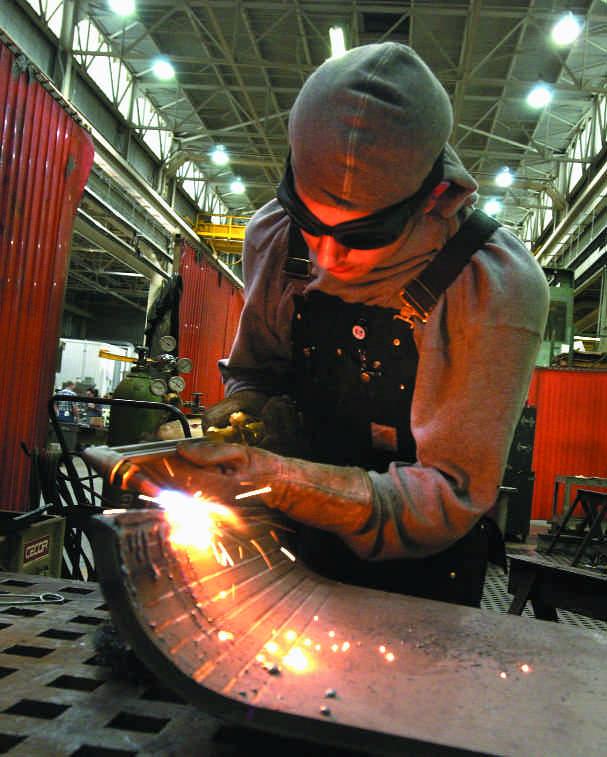
was being performed and then conducted special inspections and testing. With more than 1,250 production man-hours on the job, and working around the clock for three weeks, the stock was returned to IMF four days ahead of schedule.
“The welding work performed by the PSNS&IMF craftsmen was phenomenal,” said Baldwin. “It was absolutely flawless, and its precision and quality enabled the contractor and the IMF to progress more rapidly on other work for the project,” he added.
In Place Machining Company (IPM), a Milwaukee, Wisconsin contractor hired on s h o rt notice for the job, had became known to the IMF because of their previous repair work on the rudder of USS Abraham Lincoln (CVN-72). The IMF planners brought IPM on-site to machine down the planes, stock, hubs, and keyways to the original design specifications. After their engineers designed and built a vertical boring machine to accommodate the planes’ unique internal taper, it was then shipped to the IMF with a portable lathe that could handle the swing of the stock, since a suitable machine tool was not available at either Bremerton or Bangor.
But before any work could be done on the planes, the engineers had to design a pair of stands to hold the massive components vertically so gravity wouldn’t pull the borer off center while they were being machined. “The challenge for the stands was to come up with a design in a limited amount of time using material that was
(opposite page) An apprentice welder assists in fashioning a massive steel cradle needed to hold the dismounted fairwater planes perfectly vertical while the hubs were re-bored from above. (left) The removal of the fairwater planes from USS Kentucky (SSBN-727) revealed not only serious corrosion on the planes’ hubs and stock, but also significant misalignment of the port and starboard planes themselves. (right) In preparation for one of a series of fit checks, IMF Bangor riggers shift the newlymachined plane stock from a portable lathe supplied by In Place Machining (IPM) to a refurbished fairwater plane located outside the shop. The plane stock weighs nearly seven tons, and the fairwater planes nearly 13 tons each.
Photo by Brian Nokell, NSB Bangor Visual Information
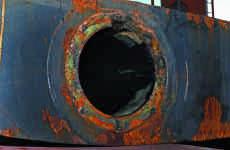
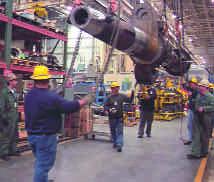
Photo by Katie Eberling, IMFACPACNW
available or could be purchased quickly,” said Marly Galindo, engineer and designer of the Navy’s first-ever vertical plane stand. “The concept was to land each plane on a bottom framework and hold the planes vertical with four pendants,” he continued. The IMF machinists then had to manufacture the stands quickly in preparation for the riggers’ expert placement of the planes inside.
Once PSNS&IMF returned the stock to IMF, machinists from both the IMF and IPM immediately went to work. “Their technical performance, response, and coordination were superb,” said Baldwin. “We needed to compress the schedule as much as possible, and IPM’s ability to fly in with their equipment and expertise was crucial in delivering the ship on time,” he added. IMF had prepared for them ahead of time by making space on an already crowded production floor and had also wrapped the planes, which were staged outside, in plastic sheeting to allow the machinists and welders to work around the clock in all weather.
It was particularly crucial to machine the taper of the stock accurately enough to ensure sufficient clearance between the planes and their roots on the submarine sail when finally installed. After several test fittings and fine adjustments, the drawkeys that hold the planes in place were repaired and reinstalled for final measurements. Minimum engineering re q u i rements are to achieve at least 75 percent contact between the surface of the stock and the internal bore of the planes. The team effort of PSNS&IMF, IMF, and IPM significantly exceeded that standard.
“With the work on the planes as the pacing item for the SSBN-737 refit, IMF had to complete the equivalent of two refits on her while accomplishing all the jobs on three other in-port submarines,” said CDR Dave Wilkie, IMF Executive Officer. “It would have been difficult to finish all of this on schedule without help f rom the PSNS&IMF work f o rce,” he added. As a result of the 15 May 2003 merger of the two activities, it became much easier to share workers to accommodate surges in maintenance requirements.
The ship’s crew wasn’t off the hook though. “They had many work-control responsibilities to get the ship prepared and tagged out, as well as performing preservation work in the sail and throughout the boat,” said LCDR Matt Feehan, IMF Machinery Division Officer. “They provided excellent support and met very rigorous work-control requirements,” he added. “Then, when the ship was put back together, they had a significant effort to test eve rything and prove out all the work,” he concluded.
Managing such a technically complex and sophisticated refit, involving more than 1,000 jobs by multiple organizations and w o rk sites, presents its challenges. In t r i c a t e c o o rdination and sequencing of work packages we re key, with much of that re s p o n s ibility on the shoulders of Tony Avila, IMF Outside Repair Su p e rv i s o r. Communication issues evaporated as people shared the pride of accomplishing something new by capitalizing on the expertise available in our n ew “One Sh i p y a rd” and adopting the best practices from throughout the Navy and p r i vate industry.
The whole IMF, from the administrative and repair departments to the waterf ro n t , a c h i e ved this milestone – with superb supp o rt from the Fleet and Industrial Su p p l y C e n t e r. But none of this could have happened without the partnerships forged with PSNS&IMF and IPM. “The teamwork has been spectacular, and that has been one of the biggest benefits of this entire effort , ” said CDR Baldwin. “We made a lot of p ro g ress on this project in solidifying longrange consolidation,” he added.
“From the riggers to the welders, shipwrights, engineers, and planners, everyone worked towards the single goal of restoring a strategic asset to maximum operational a vailability in an astonishingly short amount of time,” said CAPT Hal Barge, IMF’s Commanding Officer. “There were some skeptics out there who didn’t think it was possible, but by applying many of the concepts of the CNO’s Transformation Plan we did it,” he added.
As if there weren’t enough challenges during the refit, a final task emerged as one of the trickiest. Since Kentucky had been moved from the drydock, re-installation of the planes had to be performed while she was afloat. “Tide, current, and wind determine the parameters for a safe evolution,” said Ed Bird, Outside Repair Foreman, “and our tidal range gives us just two opportunities each day for them to come together. We needed the ship to be sitting as high and as still in the water as possible, and the large sail area of the planes meant we couldn’t take too much wind. But everything went off well due to the superb skills we have on the waterfront.”
As a direct result of being willing to a p p roach a difficult problem by “t h i n k i n g out of the box,” the Navy saved more than $700,000 on the Kentucky repair and s h o rtened the period the ship was off-line by 14 weeks. The timely return of Ke n t u c k y to sea will become the model for rapidly restoring operational availability in light of t o d a y’s demanding surge re q u i rements.
Katie Eberling is the Command Information Officer for Naval Intermediate Maintenance Facility, Pacific Northwest






